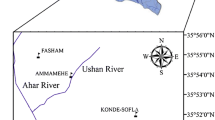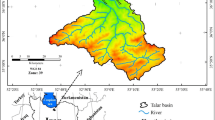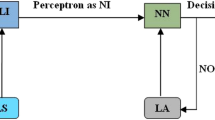Abstract
Accurate and reliable suspended sediment load (SSL) prediction models are necessary for planning and management of water resource structures. More recently, soft computing techniques have been used in hydrological and environmental modeling. The present paper compared the accuracy of three different soft computing methods, namely, artificial neural networks (ANNs), adaptive neuro-fuzzy inference system (ANFIS), coupled wavelet and neural network (WANN), and conventional sediment rating curve (SRC) approaches for estimating the daily SSL in two gauging stations in the USA. The performances of these models were measured by the coefficient of correlation (R), Nash-Sutcliffe efficiency coefficient (CE), root-mean-square error (RMSE), and mean absolute percentage error (MAPE) to choose the best fit model. Obtained results demonstrated that applied soft computing models were in good agreement with the observed SSL values, while they depicted better results than the conventional SRC method. The comparison of estimation accuracies of various models illustrated that the WANN was the most accurate model in SSL estimation in comparison to other models. For example, in Flathead River station, the determination coefficient was 0.91 for the best WANN model, while it was 0.65, 0.75, and 0.481 for the best ANN, ANFIS, and SRC models, and also in the Santa Clara River, amounts of this statistical criteria was 0.92 for the best WANN model, while it was 0.76, 0.78, and 0.39 for the best ANN, ANFIS, and SRC models, respectively. Also, the values of cumulative suspended sediment load computed by the best WANN model were closer to the observed data than the other models. In general, results indicated that the WANN model could satisfactorily mimic phenomenon, acceptably estimate cumulative SSL, and reasonably predict peak SSL values.
















Similar content being viewed by others
References
Abrahart, R. J., & See, L. (2000). Comparing neural network (NN) and Auto Regressive Moving Average (ARMA) techniques for the provision of continuous river flow forecasts in two contrasting catchments. Hydrological Processes, 14, 2157–2172.
Adamowski, J. (2010). Sun K. Development of a coupled wavelet transform and neural network method for flow forecasting of non-perennial rivers in semi-arid watersheds. Journal of Hydrology, 390(1–2), 85–91.
Adamowski, J., & Chan, H. F. (2011). A wavelet neural network conjunction model for groundwater level forecasting. Journal of Hydrology, 407, 28–40.
Altun, H., Bilgil, A., & Fidan, B. C. (2007). Treatment of multi-dimensional data to enhance neural network estimators in regression problems. Expert Systems with Applications, 32(2), 599–605.
Ardiclioglu, M., Kisi, O., & Haktanin, T. (2007). Suspended sediment prediction by using two different feed-forward backpropogation algorithms. Canadian Journal of Civil Engineering, 34(1), 1–6.
Arthur, J. H. (2003). An evaluation of sediment rating curves for estimating suspended sediment concentrations for subsequent flux calculations. Hydrological Processes, 17, 3387–3409.
ASCE Task Committee on the application of ANNs in hydrology. (2000a). Artificial neural networks in hydrology, I: preliminary concepts. Journal of Hydrological Engineering, 5(2), 115–123.
ASCE Task Committee on the application of ANNs in hydrology. (2000b). Artificial neural networks in hydrology, II: hydrologic application. Journal of Hydrological Engineering, 5(2), 124–137.
Asselman, N. E. M. (2000). Fitting and interpretation of sediment rating curves. Journal of Hydrology, 234, 228–248.
Bae, D. H., Jeong, D. M., & Kim, G. (2007). Monthly dam inflow forecasts using weather forecast information and neuro-fuzzy technique. Hydrological Sciences Journal, 52(1), 99–113.
Bayram, A., Kankal, M., & Onsoy, H. (2012). Estimation of suspended sediment concentration from turbidity measurements using artificial neural networks. Environmental Monitoring and Assessment, 184(7), 4355–4365.
Cannas, B., Fanni, A., Sias, G., Tronei, S., & Zedda, M. K. (2005). River flow forecasting using neural networks and wavelet analysis (pp. 24–29). Vienna: EGU, European Geosciences Union.
Chang, F. J. (2006). Chang YT.Adaptive neuro-fuzzy inference system for prediction of water level in reservoir. Advances in Water Resources, 29(1), 1–10.
Chang, L. C., & Chang, F. J. (2001). Intelligent control for modelling or real-time reservoir operation. Hydrological Processes, 15(9), 1621–1634.
Chang, Y. T., Chang, L. C., & Chang, F. J. (2005). Intelligent control for modeling of real time reservoir operation, Part II: artificial neural network with operating rule curves. Hydrological Processes, 19(7), 1431–1444.
Cigizoglu, H. K. (2003). Estimation, forecasting and extrapolation of flow data by artificial neural networks. Hydrological Sciences Journal, 48(3), 349–361.
Cigizoglu, H. K., & Kisi, O. (2006). Methods to improve the neural network performance in suspended sediment estimation. Journal of Hydrology, 317, 221–238.
Cobaner, M., Unal, B., & Kisi, O. (2009). Suspended sediment concentration estimation by an adaptive neuro-fuzzy and neural network approaches using hydro- meteorological data. Journal of Hydrology, 367(1–2), 52–61.
Cohen, A., & Kovacevic, J. (1996). Wavelets: the mathematical background. Proceedings Of IEEE, 84(4), 514–522.
Dastorani, M. T., Moghadamnia, A., Piri, J., & Rico-Ramirez, M. (2010). Application of ANN and ANFIS models for reconstructing missing flow data. Environmental Monitoring and Assessment, 166(1–4), 421–434.
Elci, S., Aydin, R., & Work, P. A. (2009). Estimation of suspended sediment concentration in rivers using acoustic methods. Environmental Monitoring and Assessment, 159(1–4), 255–265.
Ferguson, R. I. (1986). River loads underestimated by rating curves. Water Resources Research, 22(1), 74–76.
Firat, M., & Gungor, M. (2007). River flow estimation using adaptive neuro-fuzzy inference system. Mathematics and Computers in Simulation, 75(3–4), 87–96.
Fletcher, D., & Goss, E. (1993). Forecasting with neural networks: an application using bankruptcy data. Information and Management, 24, 159–167.
Gao, S., & Wang, Y. P. (2008). Changes in material fluxes from the Changjiang River and their implications on the adjoining continental shelf ecosystem. Continental Shelf Research, 28, 1490–1500.
Grossman, A., & Morlet, J. (1984). Decompositions of hardy functions into square integrable wavelets of constant shape. SIAM Journal on Mathematical Analysis, 15, 723–736.
Gupta, K. K., & Gupta, R. (2007). Despeckle and geographical feature extraction in SAR images by wavelet transform. Journal of Photogrammetry and Remote Sensing, 62(6), 473–484.
Heddam, S. (2014). Modeling hourly dissolved oxygen concentration (DO) using two different adaptive neuro-fuzzy inference systems (ANFIS): a comparative study. Environmental Monitoring and Assessment, 186(1), 597–619.
Jain, S. K. (2001). Development of integrated sediment rating curves using Anns. Journal of Hydraulic Engineering, 127(1), 30–37.
Jang, J. S. R. (1993). ANFIS: adaptive-network-based fuzzy inference system. IIEEE Transactions on System, Man, and Cybernetics, 23(3), 665–685.
Jang, J. S. R., Sun, C. T., & Mizutani, E. (1997). Neuro-fuzzy and soft computing: A computational approach to learning and machine intelligence. Upper Saddle River: Prentice-Hall.
Keskin, M. E., Terzi, O., & Taylan, D. (2004). Fuzzy logic model approaches to daily pan evaporation estimation in western Turkey. Hydrological Sciences Journal, 49(6), 1001–1010.
Kisi, O. (2004). Multi-layer perceptrons with Levenberg–Marquardt optimization algorithm for suspended sediment concentration prediction and estimation. Hydrological Sciences Journal, 49(6), 1025–1040.
Kisi, O. (2005a). Suspended sediment estimation using neuro-fuzzy and neural network approaches. Hydrological Sciences Journal, 50(4), 683–696.
Kisi, O. (2005b). Daily river flow forecasting using artificial neural networks and autoregressive models. The Turkish Journal of Engineering and Environmental Sciences, 29, 9–20.
Kisi, O. (2009). Neural networks and wavelet conjunction model for intermittent streamflow forecasting. Journal of Hydrological Engineering, 14(8), 773–782.
Kisi, O., & Shiri, J. (2012). River suspended sediment estimation by climatic variables implication:Comparative study among soft computing techniques. Computers & Geosciences, 43, 73–82.
Kisi, O., Haktanir, T., Ardiclioglu, M., Ozturk, O., Yalcin, E., & Uludag, S. (2008). Adaptive neuro-fuzzy computing technique for suspended sediment estimation. Advances in Engineering Software, 40, 438–444.
Kisi, O., Hosseinzadeh Dailr, A., Cimen, M., & Shiri, J. (2012). Suspended sediment modeling using genetic programming and soft computing techniques. Journal of Hydrology, 450–451, 48–58.
Kucuk, M., & Agıralioglu, N. (2006). Wavelet regression techniques for streamflow predictions. Journal of Applied Statistics, 33(9), 943–960.
Labat, D., Ababou, R., & Mangin, A. (2000). Rainfall-runoff relation for karstic spring. Part 2: continuous wavelet and discrete orthogonal multi resolution analyses. Journal of Hydrology, 238, 149–178.
Melesse, A. M., Ahmad, S., McClain, M. E., Wang, X., & Lim, Y. H. (2011). Suspended sediment load prediction of river systems: An artificial neural network approach. Agricultural Water Management, 98, 855–866.
Nayak, P. C., Sudheer, K. P., Rangan, D. M., & Ramasastri, K. S. (2004). A neuro fuzzy computing technique for modeling hydrological time series. Journal of Hydrology, 291, 52–66.
Nourani, V., Kisi, O., & Komasi, M. (2011). Two hybrid Artificial Intelligence approaches for modeling rainfall–runoff process. Journal of Hydrology, 402, 41–59.
Partal, T., & Cigizoglu, H. K. (2008). Estimation and forecasting of daily suspended sediment data using wavelet-neural networks. Journal of Hydrology, 358, 317–331.
Partal, T., & Kisi, O. (2007). Wavelet and neuro-fuzzy conjunction model for precipitation forecasting. Journal of Hydrology, 342(1–2), 199–212.
Pulido-Calvo, I., & Gutierrez-Estrada, J. C. (2009). Improved irrigation water demand forecasting using a soft-computing hybrid model. Biosystems Engineering, 102(2), 202–218.
Rajaee, T. (2011). Wavelet and ANN combination model for prediction of daily suspended sediment load in rivers. Science of the Total Environment, 409, 2917–2928.
Rajaee, T., Mirbagheri, S. A., Zounemat-Kermani, M., & Nourani, V. (2009). Daily suspended sediment concentration simulation using ANN and neuro-fuzzy models. Science of the Total Environment, 407, 4916–4927.
Rumelhart, D. E., & McClelland, J. L. (1986). The PDP research group. Parallel distributed processing: Explorations in the microstructure of cognition. Cambridge: MIT Press. 516 p.
Sayed, T., Tavakolie, A., & Razavi, A. (2003). Comparison of adaptive network based fuzzy inference systems and B-spline neuro-fuzzy mode choice models. Water Resources Research, 17(2), 123–130.
Shiri, J., Makarynskyy, O., Kisi, O., Dierickx, W., & Fakheri Fard, A. (2011). Prediction of short term operational water levels using an adaptive neuro-fuzzy inference system. ASCE Journal of Waterway, Port, Coastal, and Ocean Engineering. doi:10.1061/(ASCE)WW.1943-5460.0000097.
Syvitski, J. P. M., & Milliman, J. D. (2007). Geology, geography, and humans battle for dominance over the delivery of fluvial sediment to the coastal ocean. Journal of Geology, 115, 1–19.
Syvitski, J. P. M., Morehead, M. D., Bahr, D. B., & Mulder, T. (2000). Estimating fluvial sediment transport: the rating parameters. Water Resources Research, 36(9), 2747–2760.
Talei, A., Chua, L. H. C., & Quek, C. (2010). A novel application of a neuro-fuzzy computational technique in event-based rainfall–runoff modeling. Expert Systems with Applications, 37(12), 7456–7468.
Tayfur, G., & Guldal, V. (2006). Artificial neural networks for estimating daily total suspended sediment in natural streams. Nordic Hydrology, 37, 69–79.
Verstraeten, G., & Poesen, J. (2001). Factors controlling sediment yield from small intensively cultivated catchments in a temperate humid climate. Geomorphology, 40, 123–144.
Wang, W., & Ding, J. (2003). Wavelet network model and its application to the prediction of the hydrology. Natural Science, 1(1), 67–71.
Wang, W., **, J., & Li, Y. (2009a). Prediction of inflow at Three GorgesDamin Yangtze River with wavelet network model. Water Resources Management, 23(13), 2791–2803.
Wang, W. C., Chau, K. W., Cheng, C. T., & Qiu, L. A. (2009b). Comparison of performance of several artificial intelligence methods for forecasting monthly discharge time series. Journal of Hydrology, 374, 294–306.
Ward, P., Balen, R. T., Verstraeten, G., Renssen, H., & Vandenberghe, J. (2009). The impact of land use and climate change on late Holocene and future suspended sediment yield of the Meuse catchment. Geomorphology, 103, 389–400.
Wu, C., Chau, K., & Li, Y. (2009). Methods to improve neural network performance in daily flows prediction. Journal of Hydrology, 372, 80–93.
Yarar, A., Onucyıldız, M., & Copty, N. K. (2009). Modelling level change in lakes using neuro-fuzzy and artificial neural networks. Journal of Hydrology, 365, 329–334.
Yoon, H., Jun, S. H., Hyun, Y., Bae, G. O., & Lee, K. K. (2011). A comparative study of artificial neural networks and support vector machines for predicting groundwater levels in a coastal aquifer. Journal of Hydrology, 396, 128–138.
Yurdusev, M. A., Firat, M., & Turan, M. E. (2009). Adaptive neuro fuzzy inference system approach for municipal water consumption modeling: an application to Izmir, Turkey. Journal of Hydrology, 365(3–4), 225–234.
Zhang, W., Wei, X., Zheng, J., Zhu, Y., & Zhang, Y. (2012). Estimating suspended sediment loads in the Pearl River Delta region using sediment rating curves. Continental Shelf Research, 38, 35–46.
Zhu, Y. M., Lu, X. X., & Zhou, Y. (2007). Suspended sediment flux modeling with artificial neural network: an example of the Longchuanjiang River in the Upper Yangtze Catchment, China. Geomorphology, 84, 111–125.
Acknowledgments
The authors would like to thank two anonymous reviewers for their critical review and comments on this manuscript.
Author information
Authors and Affiliations
Corresponding author
Additional information
An erratum to this article is available at http://dx.doi.org/10.1007/s10661-015-4526-2.
Rights and permissions
About this article
Cite this article
Olyaie, E., Banejad, H., Chau, KW. et al. A comparison of various artificial intelligence approaches performance for estimating suspended sediment load of river systems: a case study in United States. Environ Monit Assess 187, 189 (2015). https://doi.org/10.1007/s10661-015-4381-1
Received:
Accepted:
Published:
DOI: https://doi.org/10.1007/s10661-015-4381-1




